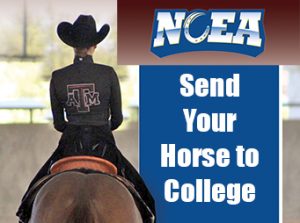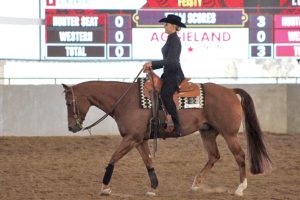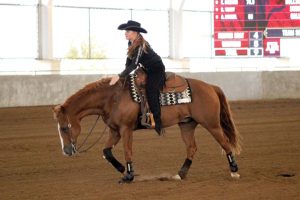NCEA – Send Your Horse To College
Click here to read the complete article
42 – October 2019
 By Cameron Crenwelge
By Cameron Crenwelge
The transformation of Equestrian from an individual sport to a team sport is difficult to understand if you’ve never attended a collegiate equestrian meet. One of the most common questions I’m asked, as a participant in this sport, is if I get to ride my own horse. Although I wish I could bring my horse with me to college and ride him every day, that’s just not how this sport works. Before diving into the details about where the horses we ride do come from, it’s helpful to provide a bit of background about the sport itself.
At a collegiate equestrian meet, spectators will see five riders from each team enter into a head-to-head competition on five different horses. A judge will score each of these competitors on their individual rides, and the rider with the highest score, in comparison to their competitor on the same horse, will be awarded a point. At the end of the meet, the team with the highest number of total points won by individual riders will come out on top.
As a result of this format, no school can be successful without access to a herd of horses. While some schools have the ability to purchase horses, the costly nature of the care and upkeep of these animals leaves the majority of schools reliant upon donations. While the idea of competing on a donated horse may sound scary at first, I can confirm that every horse that’s admitted into a collegiate program is unique in its own way and will challenge riders with opportunities for growth. Just like students, not every horse “gets into college.” The criteria are strict to ensure that each horse donated will fit into a preexisting program. Coaches are tasked with determining if a horse is mentally and physically capable of excelling in a team environment. This ensures that the team demands will not exceed the horse’s capabilities.
Texas A&M is a large school with a long-standing equestrian program; therefore, the criteria for accepting horses might be different from smaller schools or schools with newer programs. Texas A&M Head Coach Tana McKay says the team is looking for, “Western horses that have training and showing experience in Horsemanship or Reining and have the temperament to tolerate various styles of talented riders. Ideally, these horses are sound with some or little maintenance.” On the Hunt Seat side, McKay says the team is looking for “horses that have been shown successfully in three feet and up Hunter, Equitation, or Jumper divisions.”
In the cases of Horsemanship and Hunt Seat, she emphasizes the importance of a quiet mind, since these classes focus on a rider’s position and style, which can go unnoticed on the more spirited horses. Finally, McKay emphasizes the importance of good fundamentals. It’s extremely important for horses to be well-equipped to successfully maneuver through difficult collegiate patterns.
In comparison with Texas A&M, UC Davis is a smaller school with a newer equestrian team. Head Coach Jessie Weisinger participated in a helpful Q&A to explain what horse donations mean to the overall development of a new equestrian program. Weisinger says, “Horse donations are extremely important. Without horses, we essentially don’t have a team. They are our means of practice, and having a quality, four-legged teammate is important.
For start-up programs, like UC Davis, horse donations are critical. Securing the proper horses is crucial for us. When the university decided to add the program, we were starting from the very beginning. We started with no horses or equipment, so we were reliant upon people within the industry to support our program and donate or even lease horses to the team.”
What kind of horses do developing teams need?
“Just like any other team, we need horses that are suitable for Jumping, Hunt Seat Equitation, Over Fences, Flat, Reining, and Western Horsemanship. Our horses must be able to mentally and physically handle being ridden five days a week by different riders.”
Do horses need to be finished or can they be prospects?
“In our case, we were extremely limited in numbers during our first year, and we really needed horses that were finished and dependable so we could have effective practices. Having to worry about getting a young or developing horse through difficult maneuvers seen in our NCEA patterns adds a layer of difficulty and can impede the development of the team as a whole. However, as we grow and are able to expand our capacity, I would consider a prospect if I could see the horse developing into a great team horse.”
How do tax deductibles work for donations for horses?
“Donating a horse to the University of California, Davis is a great option for owners that could use a tax deduction. The paperwork will go through the university system and donors will receive confirmation from UC Davis (as a State Agency) that a donation has been made. The value of the donation is determined by you and/or your appraiser. We first require a minimum of a thirty-day trial for all possible donations to make sure the horse will be a great fit for the team and to allow us to do all the proper veterinary checks needed. After the trial period, if you’re interested in donating your horse to the program, we will need the following information:”
1. UC Davis Gift Form
2. A copy of appraisal you acquire for your horse.
3. The IRS 8283 form signed by the donor and the appraiser.
4. Any registration papers and/or licenses with signed transfers.
 What about horses with a slight lameness issue?
What about horses with a slight lameness issue?
“We understand that horses are hardworking athletes and sometimes need routine maintenance. We have our team veterinarian perform a thorough pre-purchase evaluation on all horses we consider for the team–both donations and leases. If our veterinarian feels he can manage the horse and those maintenance issues, then we’re usually willing to accept the horse and provide the required maintenance.”
As a rider and current team member of the Texas A&M Equestrian team, I can attest to the premium care that collegiate horses receive. Theraplates, chiropractors, and frequent veterinary check-ups are commonplace within most university programs. However, even though the facilities are immaculate and excellent care is guaranteed, the greatest thing these horses receive is the love of around fifty, horse-loving riders. No program is ever lacking in treats, special brushes, and care items. These horses quickly become a shoulder to cry on after a bad test or a cuddle buddy when homesickness begins to set in for a student/athlete. These horses are truly loved and appreciated by every girl on the team. They’re not treated as a means to an end but as team members with their own personalities, quirks, and preferences. So, is it time for your horse to go to college?










